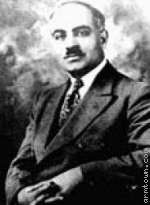Chapter XI: USSR (FROM 1920s TO 1980s)
New losses.
On December 1, 1920 as the news about the Sovietization of Armenia reached Azerbaijan, Narimanov, the chief of the Revolutionary Committee of Azerbaijan, surprisingly declared about the cessation of the Azerbaijan's claims to the Armenian territories and proclaimed Karabakh, Nakhichevan and Zanguezour, integral parts of Armenia. However, just a day later, the Narimanov's decree appeared in a slightly different wording: Nakhichevan and Zanguezour were recognized parts of Armenia, whereas Karabakh was given the right of self-determination. Nonetheless, the strange alliance between the Turks and the Russian Bolsheviks played a fatal role in the final determination of borders. The Treaty of Alexandropol, signed in December of 1920 asserted the defeat of Armenia. Then in March of 1921, Turkey and Russia signed a mysterious Treaty of Moscow to tear Nakhichevan away from Armenia and to attach it to the Soviet Azerbaijan.
In summer of 1921, the Caucasian Office of the Communist Party of Bolsheviks held a number of sessions to solve the Karabakh problem. On July 4, the plenary session issued a decree confirming the belonging of Karabakh to Armenia. However, on the next day, Stalin convened an extraordinary session to transfer Karabakh to Azerbaijan. The Treaty of Kars signed in October of 1921 completed the carve-up of Armenia. As a result of the Soviet and Turkish manipulations, the territory of the Soviet Republic of Armenia was reduced to 30,000 square km. Armenia was even deprived of Mount Ararat, its main symbol.
Fate of Nakhichevan.
During the Soviet rule, Nakhichevan, the Armenian province with the Armenian name and the unique Armenian historical and cultural heritage underwent an unprecedented period of "white genocide" and "ethnic cleansing". Predominant there in the 19th century, the Armenians composed 50% of the population in the 20s. From 1936, when the Turks of Azerbaijan became "Azerbaijanis" instead of "Caucasian Tartars", the Soviet historians followed the instructions of the Communist Party leaders and began creating the so-called "history of Azerbaijan". In order to erase any trace of the region's Armenian past, many unique Armenian monuments were destroyed, including khachkars and churches of early Christian period. The land was then extensively peopled with the Turks while the Armenians left on a large scale. According to the census of 1959, the number of Armenians in the region decreased to 1, 5%!
Stalin's purges.
From 1922 to 1936, Armenia formed part of the Transcaucasian Soviet Federal Socialist Republic, consisting of Armenia, Georgia and Azerbaijan. The new Constitution of the USSR adopted in 1936 dissolved the Transcaucasian Republic. Armenia became one of 15 Soviet Socialist Republics. Like the other Republics, Armenia was governed by the Central Committee of the Republican Communist Party. The 1st Secretaries of the Party were appointed from Moscow. In the 30s, just like the other peoples of the Soviet Union, Armenians suffered from a large-scale campaign of political terror launched by Joseph Stalin. The purges touched virtually every Armenian family. Thousands of writers, artists, scientists and political leaders were executed or exiled.
The WWII.
During the World War II, Armenians made an important contribution to the Soviet victory. Over 500 thousand of Armenians fought for the Soviet army, and half of them fell in battles. 5 Armenian infantry divisions were formed. Armenia gave 4 marshals and 60 generals. The Armenian Church and the Armenian colonies abroad donated large sums of money. After the WW II, the Armenian and Georgian Republics laid territorial claims to Turkey. However, the Soviet Government was not willing to return the Armenian lands, and shortly thereafter stated to have no claims to Turkey.
The new wave of the Armenian migration.
In 1946, many patriotic Armenians from the foreign Armenian colonies decided to repatriate to their historical homeland to contribute the post-war restoration. However, in years1948-1949, Stalin launched a new campaign of terror, and thousands of those repatriated Armenians were illegally arrested and forcibly deported to Siberia and Altay.
From the beginning of the 60s, Armenians began to emigrate from the Soviet Union on a large-scale. The Soviet leaders considered the Armenians, together with the Jews and the Germans as "unreliable elements" of the Soviet system.
The Genocide commemorated.
On April 24, 1965 the Armenians throughout the world took part in the mass meetings and manifestations, to commemorate the 50-th anniversary of the Armenian Genocide. In Yerevan, a grand monument was raised to the 1915-1921 victims' memory. Since then, the funeral marches and meetings on April 24 became an Armenian tradition. At the same time, the Armenian colonies and organizations abroad began the large-scale campaign for the recognition of the Genocide. In the 70s, a number of secret organizations were founded, such as ARA (Armenian Revolutionary Army) and ASALA (Armenian Secret Army for the Liberation of Armenia). These organizations stated to have no faith in the effectiveness of the peaceful demonstrations, and were involved in the terrorist activities. During the following decade, many terrorist attempts were committed against the Turkish representatives in the European countries, in order to attract public attention.
The Karabakh Question.
The Armenian liberation movement also manifested itself in several petitions of Armenians of Nagorno-Karabakh, requiring the reunification with Armenia. The leaders of the USSR discussed the problem in 1967-1970, while Anton Kochynian, Armenian 1st Secretary carried on the fruitless negotiations with the Azeri leaders Akhundov and Aliyev. In 1977, the problem of Nagorno-Karabakh was raised again. However, the issue was shelved again.
Karin the Builder.
Under Karin Demirchyan, the 1st Secretary from1975, the economy of Armenia went through the period of stagnation, just like the economies of the rest of the Soviet Union. However, Demirchyan succeeded in construction and house building and later was deservedly nicknamed as Karin the Builder. Various sites and new buildings modernized Armenia, especially Yerevan. Armenia became a highly urbanized Republic.
http://www.armenianhistory.info/ussr.htm
Friday, August 1, 2008
Subscribe to:
Post Comments (Atom)

No comments:
Post a Comment